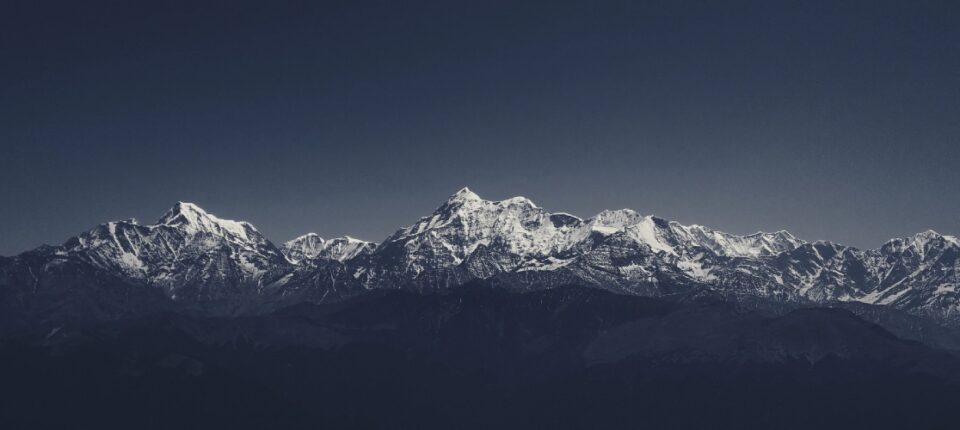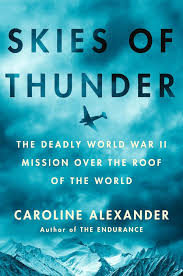At seventeen thousand feet and halfway from India to China, pilot Joseph Dechene had lost both his aircraft’s engines to ice. His lumbering cargo plane was now a glider. With white, ice-laden clouds pressed tight against the glass of its windows, the cockpit was like the inside of a bathysphere, a contraption of glass and metal churning in an abyss. The violence of the winds aloft had blown the plane so far off course that the pilots and radio operator had no idea where they were, knowing only that the peaks of high mountains were somewhere close below. Shining a light through the cockpit window, they could see ice building on the wings, but as they did, a lurch of turbulence, the worst the experienced senior pilot had ever encountered, heaved the plane upward “like an express train,” as he reported. “We came busting out the top of the thunderhead at 20,000 feet with twenty-four tons of airplane and no engine.” Above the clouds, he got the engines running again and so, eventually, safely concluded another trip over the Hump.
“The Hump” was the name that U.S. airmen had given to one the most perilous aviation missions of WW2: flying transport planes overloaded with gasoline, materiel and other supplies from India to China in the little known China-Burma-India (CBI) theater. The Japanese capture of Burma (now Myanmar) in April 1942, had closed the Burma Road, the last effective land route into China, whose ports were already in Japanese hands. President Roosevelt had pledged that no “matter what . . . ways will be found to deliver airplanes and munitions of war to the armies of Generalissimo Chiang Kai-shek,” and with the closure of the Burma Road the only remaining way was by air. Unfortunately for the U.S. airmen tasked to the fly the untested transport aircraft, the route from northeast India to Kunming, China passed through a unique convergence of deadly weather systems—and over the foothills of the Himalayas. As the expected accidents piled up, airmen spoke darkly of “the aluminum trail” of wreckage that lay scattered across mountainsides and deep jungle beneath their path.
“Below us was jungle,” recalled pilot Don Downie of his departures from his air base in Assam, India. “Personally I would sweat out this part of the trip even more than over the actual mountains. At least if you hit a hill, you had no struggle to get out.” By ‘getting out’ he meant surviving a crash or bail-out in the jungle and having to try to walk out. The first such bail-out had occurred on November 18, 1942, on a return flight from Yunnan-yi, an air field 130 miles west of Kunming, to Assam.
“The airplane ran into a very severe storm,” recalled radio-operator Matt Campanella. “[I]t was completely engulfed with fog plus heavy icing conditions” and the plane was soon lost. “The pilot, his face ashen bluish-gray from lack of oxygen and strain, ordered the co-pilot and myself to bail out.”
As the plane lurched and slipped, losing altitude, the two men hurriedly put on their parachutes. They were at about 16,000 feet. Campanella grabbed his .45, a flashlight, and a unit of “K” rations and canteen, while the co-pilot, Lt. Cecil Williams, radioed that by order of the pilot, they were bailing-out. At the rear of the plane, the men fumbled with the doors, fighting to get one open, then stood in the gaping space. White-out conditions completely obscured whatever lay below, whether mountain peaks or the jungle. “I asked, “Who’s going first? The Lt. answered, “We’ll jump together.” We interlocked arms. The Lt. looked back at me and asked, “All set?” “Set, I replied.”
As the men jumped, Campanella was instantly knocked out, perhaps by striking the door or even the tail of the plane, briefly gained consciousness, then blacked out again. He came to his senses on top of a tree some seventy-five feet above the ground with no memory of having opened his parachute. From the darkness, Lt. Williams was calling to him and the men realized they were in the same tree. As Campanella unbuckled his ‘chute, he fell to the ground, where his landing was cushioned by underbrush and vines. Lt. Williams climbed down, a painfully slow process in the darkness, taking hours. By midnight both men were on the ground together, unharmed.
Over the next twelve days the airmen wandered in the forest. By the fourth day they had exhausted their rations. Coming upon a stream, they followed its course until it became a river bounded by towering cliffs, and they swam across. Both men had lost their shoes and were now barefoot and hobbled along on makeshift crutches until, one day, as Campanella reported, “we fell to our knees and prayed God that this day we might see people and civilization of some sort.” That afternoon two native men appeared in the forest, and after an exchange of sign languages led the lost Americans to their village, a tiny compound composed of four bamboo huts inhabited by some forty souls. “They appeared to be of a mixed Chinese-Indian type,” Campanella reported. “They seemed to speak a Hindustani dialect.”
Hospitably received and generously fed, the airmen recovered. On their third day in the village, runners bearing notes written by the airmen were dispatched to they knew not where; and on the eighth day the soundof a low-flying plane was heard overhead. Shortly after the pilot walked in to report he had made a precarious landing in a small buffalo pasture just beyond the village, but for the return flight it would necessary to clear a longer runway for take-off. The plane, a little PT-17 biplane used as a trainer, was so tiny it could not carry both men on one trip.
Safely back at their air base the rescued men learned that the village runner had brought their message to Fort Hertz, a remote British outpost in the far north of Burma that—by air—was only some sixty-five miles away from where they had fallen from the sky. The men also learned that it was now December 10, and that they had been lost for 23 days and their names inscribed on the memorial list posted on their squadron bulletin board.
By the end of the war the U.S. Air Forces’ Air Transport Command had ferried an estimated 700,000 tons over the Hump. Officially, 594 transport planes were lost in the airlift, a figure that is almost certainly incomplete given the less than rigorous record-keeping: for one thing, very few reports were filed for aircraft lost before June 1943. Estimates of crew killed or missing range from 1,659 to 3861, and an astonishing 1,200 are estimated to have survived bail-outs over the mountains and jungle.
The aims of the deadly air mission had been twofold: to support Chiang Kai-shek’s Nationalist forces combat the Japanese and so prevent the “collapse” of China, and to ensure Roosevelt’s dream of a warm alliance between the U.S. and—as it was presumed—Nationalist China after the war. At war’s end many airmen questioned these objectives. Pilot James Segel probably spoke for many when he pointed out that even if China had collapsed and gone over to the Japanese, “China alone was a major headache to control, as there were many regional warlords with private armies, who were experienced in fighting guerilla wars. They could keep the Japanese military very busy.” His conclusion was that “[o]nce started, the CBI campaign was taken for granted as an essential military operation.”
Today modern advances have left the aviation epic behind. Military transports now carry payloads of 85 tons, against the Hump’s ‘giant’ C-54 aircraft’s typical six-ton payload, while the payload of the Soviet Antonov An-225 Mriya is an astounding 253 tons. All the elemental features that made the Hump route so formidable are indeed unchanged—the monsoon and winds from Asia still slam against the Himalayas—but aircraft today simply fly above them.
___________________________________


















